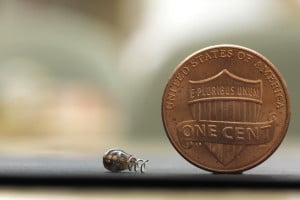
(Courtesy of Austin Yee)
Stanford researchers have developed small, implantable electronic devices that could offer an alternative to drugs using bioelectronics. The pacemaker-like devices stimulate the nervous system and treat illnesses through a therapy known as neurostimulation.
According to Ada Poon, assistant professor of electrical engineering, many diseases result from faulty electrical signals that are unable to pass through organs correctly.
Poon and her research group have devised a method to wirelessly transfer power into deep tissues and therefore enable the use of small electronics within the body. These neurostimulation chips fall into the larger category of “electroceuticals,” which use electronic stimulation to target affected areas without having the harmful side effects of drugs.
“The thing with electroceuticals is to do away with this idea of global modulation [which affects healthy biological tissues] and look directly where the diseases are at,” said John Ho, a fourth-year graduate student working in Poon’s lab.
Although much of the group’s research in the area of electroceuticals remains unpublished, Ho explained that the lab’s main contribution to the field has been wireless powering.
Using light from LEDs, the chips stimulate neurons in the brain and regulate sensory signals that indicate pain. Ho explained that they hope the neurostimulation chips will eventually be able to treat chronic pain and other diseases.
“Drug approaches have been tried for pretty much every disease. They sometimes still don’t work,” Ho said. “Any other alternative approach out there might be interesting.”
When Poon first began working on implantable wireless electronics, she read through existing literature and noted that most of the studies had been conducted half a century ago. In addition, she noticed a common error in the use of the fundamental equations describing the behavior of electromagnetic waves.
“In those analyses, it was kind of interesting to find out that they all missed one term in the math equations,” Poon said.
Poon also discovered that many of the researchers had made certain assumptions when creating their wirelessly powered implants. These assumptions forced the devices to operate in a strictly near-field region — they limited the depth at which the waves could transfer power within the body.
Poon, however, removed these assumptions and began with a basic set of equations detailing how electromagnetic waves spread.
“We realized that if we want to power wireless devices inside the body, we had to operate in the mid-field [region], which would allow us to have better efficiency,” Poon said.
Poon and her associates took advantage of the fact that wave properties change as they pass through different materials. By combining the safety of near-field waves and the penetrating power of far-field waves, they safely transmitted waves through biological tissues. This method, called “mid-field wireless transfer,” could power tiny implants within the body.
The researchers’ first major project was to make a smaller, more efficient pacemaker. Old pacemakers were clunky and limited in placement due to the batteries required to power them.
In the past half year, however, Poon’s lab has shifted to applications of mid-field wireless transfer beyond pacemakers.
“Now we’ve moved on to do neurostimulation in electroceuticals, trying to alter how waves propagate to treat diseases,” Poon said.
The neurostimulation microchips are similar to Poon’s pacemaker chip, with the exception of using LED light sources instead of electrodes.
To develop the chips, Poon’s lab has worked in close collaboration with other labs on campus, such as professor of bioengineering Scott Delp’s neuromuscular biomechanics lab.
While experiments with mice, rabbits and other animal test subjects have yielded positive results, Poon hopes to begin clinical trials with the device in the near future.
Contact Linda Xia at lindatxia ‘at’ gmail ‘dot’ com.
